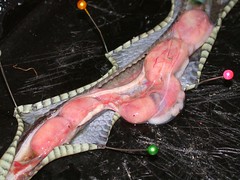Necroscopy report
Jennifer performed a necroscopy on the Butler’s garter snake last night to find out what killed her. From what I can tell, it’s something completely different from what I anticipated.
To be sure, the snake died from starvation. That was the direct cause. There was no fat and very little muscle left; the snake had metabolized it all. But the reason for starvation was that something was blocking her gastrointestinal tract: with a compressed stomach, she had no desire to eat. At first she stopped eating mice, but continued to accept earthworms. Then, at the last, she refused earthworms: the blockage was too large even for worms.
But what was the blockage? What was the cause of the hard lumps I felt along her abdomen? I suspected organ tumours, based on her advanced age. Alternatively, I worried that it might be fecoliths — hardened fecal matter in the intestinal tract — which, unlike tumours, were both preventable and treatable (so if she died from it, it would be my fault). It turned out to be neither.
 Instead, Jen discovered at least half a dozen masses that could only be infertile egg masses, trapped in the snake’s oviduct. This was perplexing. For one thing, this nearly-six-year-old snake hadn’t been so much as in the same cage as a male since shortly after her birth, so these weren’t fertile masses. Bisecting an egg mass proved as much. Second, they were much larger than I expected: Big Momma, my female red-sided garter snake (she died in late 2002), passed infertile egg masses in late 2000; they were much softer and much smaller than these masses, and Big Momma was at least three times as large as this snake. And third, they were quite firm, as hard as a jelly candy.
Instead, Jen discovered at least half a dozen masses that could only be infertile egg masses, trapped in the snake’s oviduct. This was perplexing. For one thing, this nearly-six-year-old snake hadn’t been so much as in the same cage as a male since shortly after her birth, so these weren’t fertile masses. Bisecting an egg mass proved as much. Second, they were much larger than I expected: Big Momma, my female red-sided garter snake (she died in late 2002), passed infertile egg masses in late 2000; they were much softer and much smaller than these masses, and Big Momma was at least three times as large as this snake. And third, they were quite firm, as hard as a jelly candy.
Kim suggests that this is occasionally symptomatic of older female snakes: a last-ditch effort at reproduction, perhaps. Consider, for example, that Big Momma’s last litter (in 2002) numbered 42 live babies; her previous year’s effort was only 26.
In any event, it’s not something I could have expected. Female snakes that are not exposed to males and that are not hibernated do not necessarily generate infertile egg masses; it’s only happened twice to snakes in my care. In addition to Big Momma’s slugs mentioned above, Spot, a speckled kingsnake now in Florence’s care, was eggbound in the summer of 2001, mostly because we didn’t think she was a girl (oops). In both cases, each snake had been hibernated the winter before.
The only way these egg masses would have been detected is by X-ray; and only surgery could have done something about them, if anything could be done at all. And by the time that we detected something was wrong, it was likely too late, and she was likely too old. I know it sounds like I’m rationalizing, and I probably am, but I’ve had several expensive trips to the vet where all I learned was that the snake was likely lost: either that nothing could be done, or that he could try surgery, but with a 50-50 chance that the snake would die from the operation. (My snakes don’t get slightly sick; they’re either perfectly healthy or terminal.)
Truth be told, despite being told that I’m not to blame, I’m bothered by this loss. I’ve had this snake (and her sister, who’s still going strong) longer than any other snake I’ve lost — since October 2000. As far as I know, I’m one of only two people in Canada who keeps this species in captivity. It’s listed by COSEWIC as a threatened species; I had the requisite paperwork when I was living in Ontario. Even if there really was nothing I could have done, and even if her lifespan was three times as long as any other Butler’s garter snake in captivity, I still feel responsible.